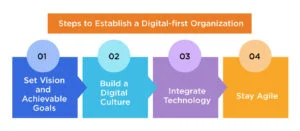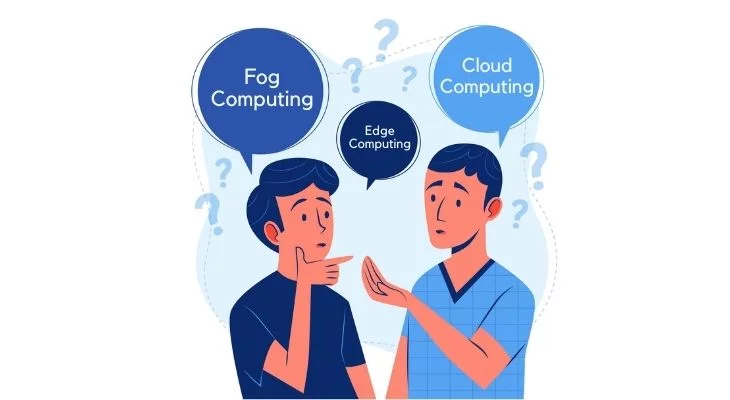Digital transformation has been a significant trend in the commercial sector lately. With the quick adoption of technology, companies are aiming to become digital-first organizations, beating the competition in the industry. But what exactly is digital transformation? Let us learn...
Digitalization or digital transformation of businesses is a step toward integrating technology in order to fulfill dynamic market requirements and attain success. Increasing technological advancement has crucially been a cornerstone for such transitions. Experts assert that more than 91% of businesses across the globe have adopted a tech-driven framework, fully or partially.
This blog shall cover the digital shift of companies alongside highlighting the intricacies of a digital-first culture and organizations.
Understanding the Digital Wave in the Business Sector:
Technological evolution has been a continuous process for quite a long time. However, the tech integration rate has reached an unimaginable height in the past decade. Doubtlessly, COVID-19 has played a key role in such a rise. The global pandemic restricted businesses from operating traditionally within office spaces, boosting the requirement for a digital-first infrastructure.
The digital shift assisted companies in many ways, including efficient operation, stronger collaboration, enhanced flexibility, faster threat detection, quality risk management, increased productivity, and more. Alongside that, the transformation supported businesses in meeting the evolving needs of the industry and staying ahead of the competitors.
Gradually, companies across the globe started thriving to become digital-first organizations, bringing about a revolution in the commercial spectrum. Sources state that the global industry for digital transformation valued at $0.911 trillion in 2024, which is anticipated to go beyond $3.289 trillion by 2030.
Cloud computing, automation, robotics, advanced cybersecurity, artificial intelligence (AI), machine learning (ML), IoT, big data analytics, blockchain, etc. are among the significant technologies driving digital transformation in diverse industries. Notably, there are several risks of becoming a digital-first company.
What Does Becoming Digital-first Mean?
Digital-first organizations typically adopt innovation in their processes, operations, and structure, sustaining agility and a dynamic approach. Therefore, becoming digital-first means initiating a technological shift to move away from traditional operating methods. Such an approach does not indicate the installation of multiple software, but an architecture where informed technological steps are taken to address tasks and functionalities. It is an initiative to preserve a profitable digital future within an organization.
Becoming digital-first also signifies building a technologically aware team with the capability to use digital components while executing their responsibilities. A tech-native company focuses on bringing efficiency in all its activities using digital tactics. For this purpose, firms create and follow certain policies, considering several ethical components.
Core Features of Digital-first Organizations:
High Agility:
Digital-native companies encourage agility in their process while operating in odd situations. Such organizations adopt innovation to address complex tasks. The incorporation of the trial-and-error method is quite common in a digital-first culture, allowing companies to implement different strategies if one fails.
Data-driven Solutions:
Digital-led organizations largely depend on data. They use technology not only to gather valuable datasets but also to analyze these to extract key insights. Moreover, data-centric tactics are relevant, appropriate, and are more likely to be successful.
Omni-channel Approach:
Organizations with a digital-first process leverage multiple channels at a time while engaging and establishing relationships with their probable prospects. Technological methods enable identifying the most suitable channels to reach the target audience, offering firms the opportunity to engage with their audience more impactfully.
Enhanced Digital Literacy:
The workforce of digital-first organizations is typically more technologically aware than other firms. They are well-informed about how to use digital elements to execute a specific task. For this purpose, companies with a tech-centric culture organize continuous training sessions.
Focus on Customers:
Tech-first firms usually keep their focus on their customers. The strategies, products, and services prioritize the needs and expectations of the audience. Such firms intend to offer personalization to their customers while establishing long-term relationships.
How to Establish a Digital-first Organization?
Constructing a digital-first firm requires thorough planning, strategies, and execution capabilities. The process involves several stages, and each needs high precision.
Step 1- Set Vision and Achievable Goals
While establishing a digital-first company, the primary requirement is to set certain objectives that simplify the alignment of digital strategies with overall business goals. Alongside that, it is necessary to analyze the ongoing state of the organization, which assists in determining attainable goals.
Step 2- Build a Digital Culture
Sustaining a digital culture is a core element of tech-native firms, where leadership, communication, and employee training play important roles. In this regard, leadership, accompanied by impactful communication, should empathically encourage the 'digital-first' mindset among employees. Apart from that, training for digital awareness and literacy enables employees to learn how to utilize technology to boost their productivity.
Step 3- Integrate Technology
After setting goals and training the employees, organizations have to initiate technological integration. The process includes investment decisions, infrastructure setup, and the installation of both software and hardware.
Step 4- Stay Agile:
Sustaining agility is the final yet important step of digital-first organizations that enables flexibility during tech transition and afterward. However, making data-driven decisions is also necessary in the entire process, putting the customer requirements first.
From Analog to Digital — Identifying the Key Challenges of Becoming a Digital-first Organization
Unavailability of a Change Management Strategy:
Shifting to a digital-first culture is a remarkable transformation of organizational operations and functionalities. However, a common challenge raised here is constructing a change management strategy due to which, organizations fail to meet their predefined goals and build a digital-native architecture.
Financial Limitations:
Financial constraints are major difficulties in establishing a digital-first organization. Digital transformation is expensive as it includes advanced tools and applications. Alongside that, employee training also requires considerable investment. Organizations with low budgets may not be able to successfully shift to digital architecture.
Complex Technologies and Lack of Appropriate Skills:
Technologies nowadays are very complicated to operate. They include advanced features and policies that can confuse individuals with limited understanding. Therefore, complex technologies and confined knowledge about them can be significant obstacles to a digital shift.
Security Issues:
Alongside several benefits, a digital-first culture also welcomes remarkable cybersecurity concerns. Data is an asset for businesses, and in a tech-led atmosphere, data is managed digitally. Security weaknesses in systems and applications can cause significant data breaches. Hence, security parameters can create challenges while becoming a digital-first organization.
Inability to Measure ROI:
Initiating a digital transformation requires considerable investments, and the inability to measure its returns can create difficulties for companies. Assessing returns may take longer and can be a complicated process. However, overlooking them can impact the progression of a company.
Paving the Path to a Digital-First Architecture!
Digital shift is indeed essential for businesses with a long-term vision for progression. Moreover, it is important to fulfill the dynamic needs of the target audience and stay ahead of the competitors. Constructing a digital-first organization enables businesses to stay agile and make data-driven decisions.
Nevertheless, there are several challenges to such transformation, including appropriate change management plans and training for non-technical employees. Therefore, it is important to identify and strategize to overcome each hurdle for a successful digital transition.
Know more about technological trends and practices with us. Read our other informative blogs.
Also Read:
The Emergence of Virtual Avatar: Key Advantages in Business, Tools, and More
Digital Out-of-Home (DOOH) Advertising: Data-Driven Strategies for Effective Marketing






